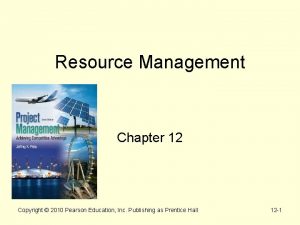Resource Management Chapter 12 Copyright 2010 Pearson Education













- Slides: 13

Resource Management Chapter 12 Copyright © 2010 Pearson Education, Inc. Publishing as Prentice Hall 12 -1

Types of Constraints q Time q Resource q Mixed Copyright © 2010 Pearson Education, Inc. Publishing as Prentice Hall 12 -2

Resource Loading The amounts of individual resources that a schedule requires during specific time periods. Resource loading table Resource Name Tom Assign Bids Jeff Work 40 hrs Details 5/5 5/12 5/19 5/26 Work 8 h 32 h Calculate Cost Sue Select Bid Carol PR Campaign 40 hrs 8 hrs Work Work Copyright © 2010 Pearson Education, Inc. Publishing as Prentice Hall 8 h 8 h 8 h 32 h 32 h 8 h 8 h 12 -3

Resource Leveling (Smoothing) A multivariate, combinatorial problem Objectives • To determine the resource requirements so that they will be available at the right time • To allow each activity to be scheduled with the smoothest possible transition across resource usage levels Copyright © 2010 Pearson Education, Inc. Publishing as Prentice Hall 12 -4

Prioritization Rules for Leveling v Smallest amount of slack v Smallest duration v Lowest ID number (FCFS) v Greatest number of successor v Requiring the most tasks resources Copyright © 2010 Pearson Education, Inc. Publishing as Prentice Hall 12 -5

General Procedure for Leveling 1. Create a project activity network diagram 2. Develop resource loading table 3. Determine activity late finish dates 4. Identify resource over allocation 5. Level the resource loading table Copyright © 2010 Pearson Education, Inc. Publishing as Prentice Hall 12 -6

Creating Resource Loading Charts (1/4) Display the amount of resources required as a function of time. 4 B 5 Res = 2 0 A 4 Res = 6 5 D 9 Res = 7 9 E 11 Res = 3 1. Start with a network diagram 4 C 7 Res = 2 Copyright © 2010 Pearson Education, Inc. Publishing as Prentice Hall 11 F 12 Res = 6 12 -7

Creating Resource Loading Charts 2/4 Activity Resource Duration A 6 4 B 2 1 C 2 3 D E F 7 3 6 4 2 1 ES 0 4 4 Slack 0 0 4 LF 4 5 11 5 9 11 0 0 0 9 11 12 2. Produce a table that shows the duration, early start, late finish, slack, and resource(s) required for each activity. Copyright © 2010 Pearson Education, Inc. Publishing as Prentice Hall 12 -8

Creating Resource Loading Charts 3/4 3. Draw an initial loading chart with each activity scheduled at its ES. Resources 8 6 4 A D B 2 C 2 4 F Resource imbalance E 6 8 10 12 Project Days Copyright © 2010 Pearson Education, Inc. Publishing as Prentice Hall 14 12 -9

Creating Resource Loading Charts 4/4 4. Rearrange activities within their slack to create a more level profile. Splitting C creates a more level project. Resources 8 6 4 A B 2 C 2 4 D C F E 6 8 10 12 Project Days Copyright © 2010 Pearson Education, Inc. Publishing as Prentice Hall 14 12 -10

Key Parameters in Multi-Project Environments Ø Schedule slippage Ø Resource utilization Ø In-process inventory Copyright © 2010 Pearson Education, Inc. Publishing as Prentice Hall 12 -11

Prioritizing Resource Allocations in Multi-Project Environments • First come first served • Greatest resource demand • Greatest resource utilization • Minimum late finish time • Mathematical programming Copyright © 2010 Pearson Education, Inc. Publishing as Prentice Hall 12 -12

Copyright © 2010 Pearson Education, Inc. Publishing as Prentice Hall 12 -13
 Copyright 2010 pearson education inc
Copyright 2010 pearson education inc Copyright 2010 pearson education inc
Copyright 2010 pearson education inc Copyright 2010 pearson education inc
Copyright 2010 pearson education inc Copyright 2010 pearson education inc
Copyright 2010 pearson education inc Copyright 2010 pearson education inc
Copyright 2010 pearson education inc Copyright 2010 pearson education inc
Copyright 2010 pearson education inc Copyright 2010 pearson education inc
Copyright 2010 pearson education inc Copyright 2010 pearson education inc
Copyright 2010 pearson education inc Composition copyright example
Composition copyright example Pearson education inc all rights reserved
Pearson education inc all rights reserved Pearson education limited 2017
Pearson education limited 2017 Copyright pearson education inc
Copyright pearson education inc Copyright 2009
Copyright 2009 Copyright pearson education inc
Copyright pearson education inc

























